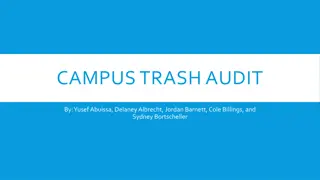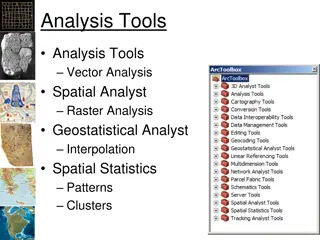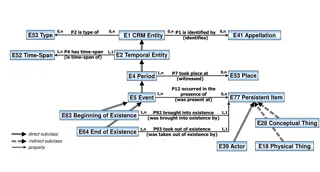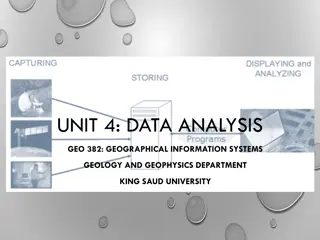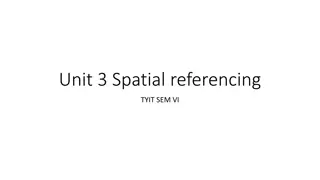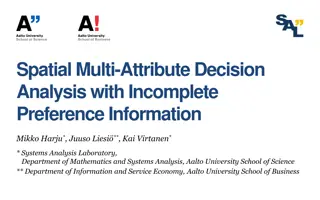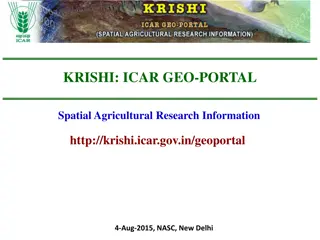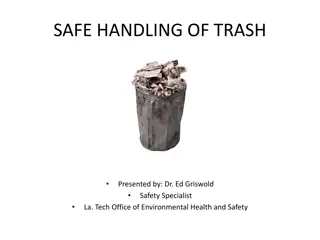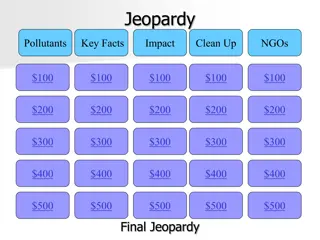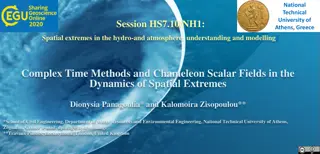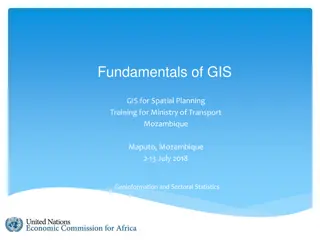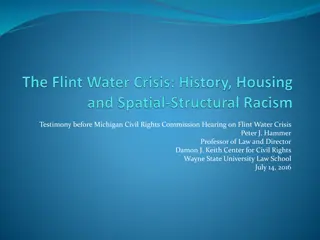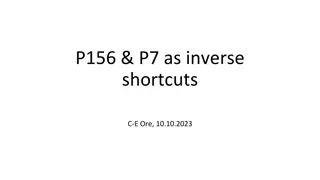Understanding the Spatial Dimensions of Trash
Exploring the spatial impact of trash generation and disposal, this content delves into the role of local solid waste authorities in managing waste, promoting recycling, and ensuring proper waste disposal practices. From defining solid waste to the functions of waste authorities, the importance of responsible waste management is highlighted.
Download Presentation

Please find below an Image/Link to download the presentation.
The content on the website is provided AS IS for your information and personal use only. It may not be sold, licensed, or shared on other websites without obtaining consent from the author. Download presentation by click this link. If you encounter any issues during the download, it is possible that the publisher has removed the file from their server.
E N D
Presentation Transcript
SPATIAL DIMENSIONS OF TRASH: 'CALL YOUR LOCAL SOLID WASTE AUTHORITY' Barbara L. MacLennan, graduate student, WVU Department of Geology & Geography, Regional Director, Project A.L.E.R.T Bobbi Benson, Executive Director, Marion County Solid Waste Authority Terry Ryan, WVU Department of Engineering Bridget Benson, Program Manager, Marion County Solid Waste Authority Project A.L.E.R.T Gabby Lively, Program Assistant, Marion County Solid Waste Authority Project A.L.E.R.T
Trash is a by-product of living Waste has always dogged humanity but it won t become a problem until the day space begins to contract. An Ontology of Trash: The Disposable and its Problematic Nature (2008) Solid waste means any garbage, refuse, sludge from a wastewater treatment plant, water supply treatment plant, or air pollution control facility and other discarded materials including solid, liquid, semi-solid, or contained gaseous material, resulting from industrial, commercial, mining and agricultural operations, and from community activities, but does not include solid or dissolved materials in domestic sewage, or solid or dissolved materials in irrigation return flows or industrial discharges that are point sources subject to permit under 33 USC 1342, as amended (86 Stat. 880), or source, special nuclear or by-product material as defined by the Atomic Energy Act of 1954, as amended (68 Stat. 923) except as may be provided by existing agreements between the State of New York and the government of the United States (see section 360-1.3 of this Part). State of New York, 2014
Trash Has Always Been Spatial John Snow 1854 map of cholera cases Thames Bubbler Re-oxygenation Barge
"Call your local solid waste authority" Local Solid Waste Authority Quasi-governmental non-profit organization that promotes proper waste disposal and recycling No official designation No regulatory or enforcement powers Commonly employs 1- 2 people, unless can create value added Recycling facility, supervise litter control Sometimes operates a recycling facility which sells commodity bales on the global market through a commodities broker. Type of commodity is population density driven - clustering Highly dependent on available transportation routes traveling salesman Sold directly on the global commodities market jumps scale Often the first contact residents, businesses, gov t offices call about disposal issues of ANY KIND.
The Project Based on the success of four previous USDA recycling/disposal pilot projects
Project A.L.E.R.T assistance lowering environmental rural toxins To increase proper disposal and rural recycling, promote proper storage and handling prior to disposal, and keep rural toxins out of the water system by providing accurate information Categorize waste by item/create interactive map of disposal locations Project A.L.E.R.T Network Proper Medication Disposal Small Farm Audits in collaboration with WV Farm Bureau/WV Department of Agriculture State Solid Waste -STEM Workshop in collaboration with NASA STEM Hands-on Historical Exhibits
Environmental Rural Toxins Household Hazardous Waste is generally: Paint, Batteries, CFL Bulbs, Cleaning Products Our definition need to encompass a multitude of household items that fall below regulations: Aerosol Cans . Antifreeze . Batteries . Bale Wrap . Brake Fluid . Bug Killer . Cleaners . CFL Light Bulbs . DDT. Disinfectants . Drain Cleaner . Essential Oils. Gasoline . Manure . Medicines . Mercury . Mothballs . Oil . Paint . Pesticides . Rat Poison . Waste Fuel. Weed Killers. Cloridaine, and HUNDREDS more
Salient Events, Incidents, Constraints Multi-scalar, Multi-jurisdictional Transboundary Openshaw s Classic MAUP
U.S. TRASH: SCALE OF THE HOUSEHOLD Brenner/Marston Debate: Dismissive of Household Scale Waste audit literature: Rural areas un-auditable black hole Nationally: Rural residents have space to store stuff Corporate: Residents bear onus of proper disposal Bury it, Burn it, Reuse It, .. Store It Stockpiling is a fire hazard to residents and EMS Attractive to methamphetamine makers Some items degrade and become more potent New residents move in and can t identify items Their choice becomes Safety or the Environment
The Impact Solid waste isn t considered infrastructure like: transportation, energy, sewage, water University Towne Centre Morgantown, WV $25M+ to build Didn t think about trash service/recycling until AFTER built Road had to be retroactively built for trash trucks/bins. Call Your SWA Still only one access road. The Story of Stuff
Rural waste audit .Item by Item State and County Advice: Resident calls SWA Generic Call your SWA Call your Fire Department SWA refers to disposal group Rural people don t care about the environment Scale-Less Take it to your nearest Institutional Hubris Household Scale To handle this at home Resident: Calls another group Gets frustrated Dumps the item Stores the Item Puts it in the trash Disposal group refers resident to SWA Project A.L.E.R.T Team
MERCURY EPA says to take to nearest facility in Philadelphia Pint size jars of mercury are the egnima of rural waste Eureka! Legacy item from farm and old industries Residents were told that mercury is worth money Found in old houses and barns by new residents Fun! Harmless! I use it at home! Used to cheat in Pinewood Derby EPA Image from School
Propane Tanks 60 million people use propane for heating and cooling primarily in rural areas Despite exchange programs, tanks seem to multiply. Private metal dealers can t accept due to meth risks. Carried down river from homes during floods. Temporal event
MEDICATION Proper Medication Disposal is a Huge Problem Medication bottles can t be recycled due to leachate Medication can t be donated to clinics due to regulations Home health care can t remove medication from home or flush it Take Back programs are overburdening space in police stations Incineration depends on proximity to Ohio or Indianapolis Disposal containers go into trash WV has the highest rate of accidental poisonings WV has a high rate of meth labs Medication kills off good bacteria in septics 4000 + homes sewage go into waterways
Tragedy of the Commons Who gave companies permission to tell people to call solid waste authorities? Who caused this? A SWA Director, volunteer basis Each item has a small impact in itself Aggregated by household it creates toxic body burden on the community, environment, and world. The reaction by most agencies and organizations is Whoaa I had no idea.
Solid Waste Mangement Process Household scale: A small part of the solid waste cycle Solid Waste makes $75 Billion Revenue for the U.S. Mostly manufacturing from recycled materials and energy Many items aren t reusable or incineratable
Expanding the Pilot Project collaboration, journal articles, modules If we can land a man on the moon, why can t we solve the problems of the ghetto? Nelson (1960, 2011) Because we need to break through the preconditioned constraints or boundaries of our own disciplines, agencies, and preconceptions .
As Promised. Exploding Landfills Romans built sophisticed landfills similar to those built in the modern day. Both have a propensity to blow up due to shifting and methane build up. Conde Naste
United States Department of Agriculture Project A.L.E.R.T Team Barbara MacLennan, Regional Facilitator Bobbi Benson, MarCoSWA Executive Director Bridget Benson, Stakeholder Network Mary Benson, Hands-on Education in Context Gabby Lively, Farm Outreach/FFA William E. Vehse Endowment for Graduate Travel WVU Geology & Geography Travel Scholarship


